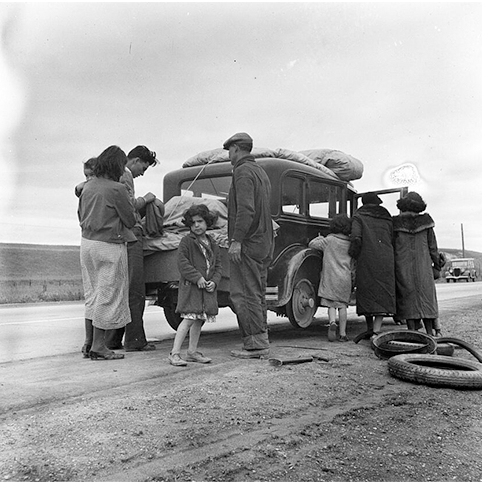INS Records for 1930s Mexican Repatriations
Mexican-American family historians and other interested researchers occasionally contact the History Office in search of “Mexican Repatriation” records for individuals who left the U.S. during the Great Depression (1929-1939). Many of these researchers believe that the Immigration and Naturalization Service (INS) conducted a large-scale federally-controlled Mexican repatriation program during the Depression and thus expect USCIS to hold INS records documenting their ancestor’s exit from the U.S.

Photo by Dorothea Lange for the U.S. Farm Security Administration.
Courtesy of Library of Congress Prints and Photographs Division Washington
In most cases, however, no federal record exists for these departures. This is because, while an estimated 400,000 to 1 million Mexicans and Mexican-Americans left the US for Mexico during the Depression, relatively few of them were expelled under formal INS-directed removal proceedings. The majority returned to Mexico by their own decision or through officially voluntary – though often coercive – repatriation programs directed by state and local governments and charitable aid agencies.
INS did increase its deportation efforts during the 1930s and on several occasions the agency co-operated with local governments who sought to remove Mexicans from their jurisdictions. These actions understandably contributed to the current belief that the INS led a massive repatriation program. In reality, INS’s role in the removal process was somewhat more complex.
In1930, as the extent of the Depression became more clear some Americans accused Mexicans, as well as other aliens, of holding jobs needed by U.S. citizens. At the same time, local relief agencies began to feel the strain of using decreasing resources to serve an increasingly needy populace. Many agencies felt pressure to exclude foreign-born applicants from receiving aid. Some agencies and local governments began requiring applicants to show proof of legal residence. Others used the threat of federal immigration law, which held that immigrants who became “public charges” could be deported, to discourage them from requesting aid. These conditions likely caused many Mexicans to consider returning to their native country.
Some migrants who chose to return to Mexico received aid from Mexican consuls in the US or ticket money from various aid organizations. Many other Mexicans made their own way to the southern border. In some cases, the threat of federally mandated deportation – often made by local law enforcement agencies – played a role in immigrants’ decision to leave the U.S., though the INS never actually instituted removal proceedings.
Voluntary repatriations, in which

Photo by Dorothea Lange for the U.S. Farm Security Administration.
Courtesy Library of Congress Prints and Photographs Division Washington, DC.
Mexicans who returned home under these circumstances were considered “voluntary” repatriations because though they faced great pressures and sometimes actual threats from local authorities, they returned to Mexico outside of official federal removal proceedings.
While many Mexicans left on their own accord, others were aided or pressured by state and local repatriation programs. By the early1930s local governments began to organize repatriation programs designed to remove Mexicans from their relief rolls. The largest and most well-known of these efforts took place in Los Angeles, but several states and localities launched similar efforts.
In some cases, INS aided local repatriation programs. For the most part, however, the agency instituted federal removal proceedings in only a relatively small number of cases. In Los Angeles County, for example, INS sent federal immigration agents to conduct raids and hold removal hearings. In a number of high profile raids in 1931, the agency arrested 389 deportable aliens, 269 of whom were Mexican.
A more important result of those raids, however, was that the threat of increased federal deportations likely hastened the departure of thousands of Mexicans. In the months following the raids, LA County hired trains and transported thousands of Mexicans to the Mexican border.
For researchers today, it is important to note that only those removals carried-out by the INS (the 389 cases cited above), and perhaps a small number of other investigative cases, would have generated an agency file. The vast majority of migrants who left on LA County’s trains likely have no INS deportation record.
Likewise, in 1933 the INS reported that the State of Michigan “sent” 1500 Mexicans to the border accompanied by an Immigration Service escort. Because these migrants were removed under a state-sponsored program it is unlikely that INS deportation files exist for them.
During the Depression, the INS did increase its efforts to deport unlawfully present immigrants. Though the effort was not aimed expressly at Mexicans it affected them more than other nationalities. For example, in 1930 Mexicans accounted for over half of all deportations. In the early 1930s, the INS sought publicity for its federal deportation campaign and received considerable press attention.
Press coverage for the INS’s deportation efforts, both positive and negative, ran concurrently with coverage of local repatriation programs. Thus contemporary reports often conflated federal deportations with removals by local programs and/or the scores of Mexicans who returned to Mexico on their own. As a result, newspapers of the era often over-reported deportation totals.
For example, in 1931 The Salt Lake Desert News quoted immigration officials as claiming that in Southern California 70,000 Mexicans had “been deported to their native country….” INS statistics, however, show that in 1930 the agency deported a total of 18,142 aliens, 8,335 of whom were Mexicans. Exaggerated reports like this one have led some researchers to see Mexican repatriation in the 1930s as the result of a single massive program, rather than a combination of several factors.
In all, during the peak years of the repatriation campaigns (1929-1935), the INS formally removed approximately 82,000 Mexicans. These removals were accomplished through both deportation and voluntary departure proceedings (formal voluntary departure proceedings provided an alternative method of removal that allowed aliens subject to deportation to leave at their own expense, saving the government the cost of detention and deportation hearings while allowing the alien the possibility of future legal re-entry). Therefore, depending on which estimate you accept, INS removals accounted for roughly between 8 to 20% of all Mexicans who returned to Mexico during the first 6 years of the Depression. For that reason the majority of researchers seeking “INS repatriation records” from the Great Depression will not find them.
